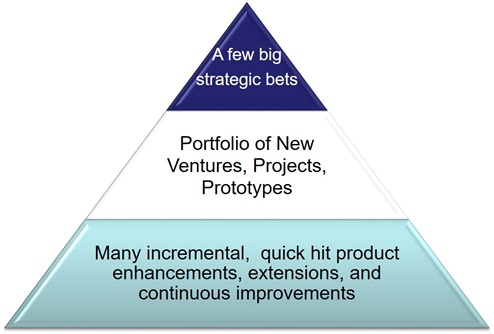 Companies with a successful innovation track record typically have a well developed business strategy. When the organization knows “where it needs to go” then portfolio discussions for new products is much easier. So what are some of the elements of new product strategies?
Companies with a successful innovation track record typically have a well developed business strategy. When the organization knows “where it needs to go” then portfolio discussions for new products is much easier. So what are some of the elements of new product strategies?
Let’s take a look at some:
- Defending versus extending current product base
- Project types; fundamental research, product development, process development, maintenance
- Short-term versus long-term
- High-risk versus low-risk
- Markets; Stay in existing markets, expand into adjacent markets (white space) or go into totally new markets
- Products; modify with existing products, extend current product lines (line extensions), or develop totally new products
- Technology approach: modify with existing platforms, extend current platforms, or develop totally new ones
- Ease of development (tied to risk)
- Geographic considerations (Asia, Europe, etc.)
Rosabeth Moss Kanter, a professor at MIT developed the new product triangle below to capture the typical mix of the new product types.
Most companies “anchor” their new product portfolio with incremental product improvements, or easy/fast product enhancements. You can think of many types of new products in this category. How about “new and improved” Tide dishwashing soap or 5 minute epoxy versus 20 minute epoxy. The cell phone industry focuses on incremental product improvements. A smart phone is still a smart phone, but think of all the generations of the iPhone, Samsung, Motorola, etc. Some might not appreciate the constant product “tweaks” in smart phones. I just got a new Motorola Droid after having my first Droid for about 4 years. I was constantly baffled with all of the new changes in the menus, apps, and how the darn thing just worked. Something as simple as putting it into airplane mode was not intuitively obvious. I had to ask my son-in-law for a tutorial.
The next rung on the pyramid is where new products fit into the strategy. These are defined as new to the company but not necessarily new to the world. A good example as when IBM entered the PC market in the early 1980’s. The PC was a new product for IBM at the time whose main business was large mainframe and mid-range computers. Other examples are Canon developed the laser printers after Hewlett Packard invented them. Apple introduced the iPod (new to Apple) but they were not the first to invent the mp3 player.
The new to the world new products at the top of the pyramid are first of their kind and create a whole new market. Examples of these are automobile, train, airplane, Post-It notes, GPS, laser, integrated circuit, personal computer, cell phone, internet, Sony Walkman, and many others.
In polymers, new to the world new product included some of the great DuPont innovations such as Nylon (polyamides), Neoprene (synthetic rubber), Teflon (polytetrafluoroethylene), Lycra (polyester), Lucite (polymethylmethacrylate), Kevlar (Poly(p-phenylene terephthalamide)), and Kapton (PMDA-ODA aromatic polyimide). Some notable Dow innovations are Styrofoam (expanded polystyrene) and Saran Wrap (polyvinylidene chloride). Note: Saran wrap was converted to low density polyethylene in 2004 on environmental concerns over the chloride content of the original compound (an example of a product improvement on a breakthrough new product).
Typical allocations for the three types of new products:
- New to the world products are about 10%
- New products are about 20%
- Product line extensions and modifications are about the remaining 70%
- additions to existing product lines (25%)
- improvements to exiting products (30%)
- repositioning and cost reduction/new packaging (15%)
Take a minute to think about the new product development portfolio at your company and evaluate what allocation of the three types of new products are in your NPD portfolio.


Leave a Reply